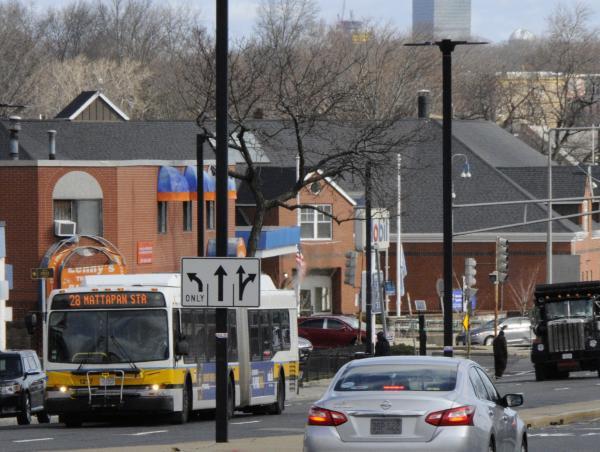March 14, 2019

A Route 28 bus makes it way down Blue Hill Avenue near Morton Street. File photo
Mayor Walsh wants to make improvements to Blue Hill Avenue bus service a key part of his plan for better transportation infrastructure in the city. In a speech at the Boston Municipal Research Bureau’s annual meeting last Thursday, the mayor announced that the city will “start a community process to improve bus service on Blue Hill Avenue” while piloting new dedicated peak-hour bus lane on Brighton Avenue in Allston.
In the days after the speech, city transportation officials have said that a dedicated bus lane is not necessarily what the mayor has in mind for Blue Hill Avenue. It is one option, they say, in a suite of options that he hopes will be considered over the next year.
“We work hand in hand with local community groups to design the specifics and to figure out: Do we need a bus lane? Do we need to improve our traffic signal timing? Do we need to change the location of bus stops?” said Vineet Gupta, director of policy and planning for the Boston Transportation Dept. (BTD).
“We don’t want to announce any specifics until we have had that conversation and public meetings with the local communities.”
The conversation will start with elected officials and community leaders, according to Gupta, who added that the BTD will “go in with an open mind.” The community process will start this fall, with the conversation continuing well into next year.
This will not be the first time that a significant change to bus travel on Blue Hill has been contemplated. In 2009, a proposal by the Patrick administration— dubbed 28X— sought to replace the existing Route 28 bus line with a Bus Rapid Transit (BRT) system. In concept, it included dedicated bus lanes from Mattapan to Grove Hall on Blue Hill Ave and from Townsend to Moreland streets on Warren Street. The project would have renewed signal equipment at 36 crossroads to allow buses to jump queues.
James Aloisi, the state secretary of transportation under Gov. Deval Patrick, was the chief proponent of the 28X concept. In seeking federal funding to help pay for the project, Aloisi said a new BRT system would bring construction jobs and connect residents with jobs throughout Boston area.
The proposal, however, was unpopular with Mattapan, Roxbury and Dorchester residents, who were concerned with the loss of space for a proposed Silver Line bus, of trees and flowers, and of parking. In November 2009, elected officials from the city asked the state to withdraw the application.
Aloisi, who now serves as the content director of Transit Matters, said he’s delighted that “we are going to take a second shot at it.”
He added that he never gave up the idea of replacing the 28 bus with a BRT system with dedicated bus lanes and traffic signal priority.
“We didn’t have time to do what needs to be done, to go out to the community to work with people and persuade people that what we can do is helpful,” said Aloisi. “We need to learn from the mistakes in the past.”
State Rep. Russell Holmes, who came into office after the 28X proposal was shelved, noted that people in Mattapan are more enthusiastic about a dedicated bus lane, but he added that Roxbury residents have concerns about narrowing the streets on their end of the route, pointing out possible solutions to traffic on Blue Hill Ave: Traffic lights should be synchronized; conversations should be structured around how to share the road between cars, bikes and buses; and dedicated bus lanes to relieve congestions at some bottlenecks.
If the BTD wants to start a conversation about what people need, Holmes said, it should start with the Roxbury-Dorchester-Mattapan transit need study, a 2012 study based on a survey with over 1,300 residents.
In addition to some quick fixes, the study recommended light rail extensions in the long term. “The community is well-informed and clearly they prefer light rails,” Holmes said.
Aloisi dismissed that idea. “If you keep asking for light rail, you will not get it because it’s too expensive,” he said. “A true dedicated bus route system will function just like the light rail at half the cost.”
To get community feedback, Aloisi said, it’s not enough to just have neighborhood meetings. “You have to get on the bus and ask people who ride the bus every day.”
Michael Kozu, the interim co-director of Project R.I.G.H.T Inc., a Dorchester organization centered in Grove Hall, disagreed.
“They should not just try to get the commuters from Mattapan to downtown, they should look into the impact on surrounding neighborhoods,” he said.
The 45 and 28 buses are slow, Kozu agreed, but he said that constructing a dedicated bus lane or implementing signals that prioritize buses will take away parking space and make it more difficult for cars and pedestrians to cross the streets. He said the city should look to gas tax or taxes on Uber and Lyft to reduce traffic in the area.
Vivian Ortiz, a transportation advocate in Mattapan, said it’s a good idea for the city department to ask for the community’s opinions before moving forward. She would like to see the department reaching out to users of public transit with interpreters.
She said that Blue Hill Avenue should be considered as a shared space, one that can be safely used by everyone: people who are on a bus, on a bicycle, on foot, or driving themselves.
“Giving priority to bus is important because it’s an efficient way to move people around, but they should be willing to listen to folks that use multiple ways of travelling and give everyone space,” she said.


